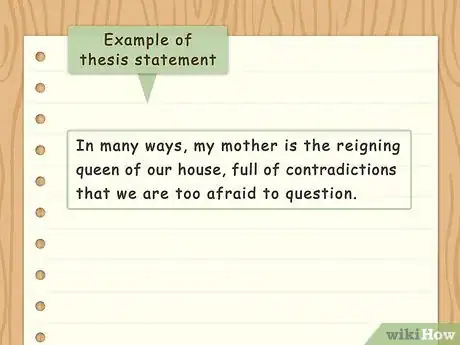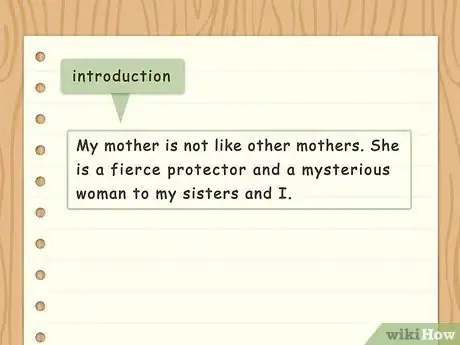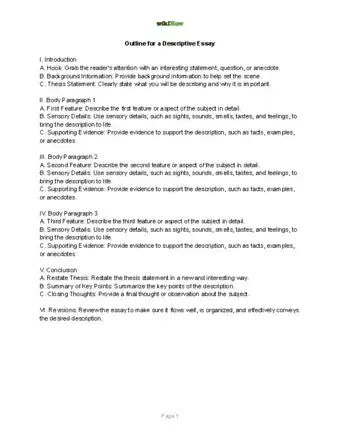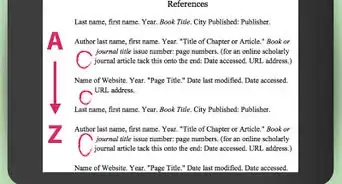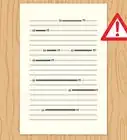This article was co-authored by Jake Adams. Jake Adams is an academic tutor and the owner of Simplifi EDU, a Santa Monica, California based online tutoring business offering learning resources and online tutors for academic subjects K-College, SAT & ACT prep, and college admissions applications. With over 14 years of professional tutoring experience, Jake is dedicated to providing his clients the very best online tutoring experience and access to a network of excellent undergraduate and graduate-level tutors from top colleges all over the nation. Jake holds a BS in International Business and Marketing from Pepperdine University.
There are 7 references cited in this article, which can be found at the bottom of the page.
wikiHow marks an article as reader-approved once it receives enough positive feedback. This article has 30 testimonials from our readers, earning it our reader-approved status.
This article has been viewed 1,456,823 times.
A good descriptive essay creates a vivid picture of the topic in the reader’s mind. You may need to write a descriptive essay as a class assignment or you may decide to write one as a fun writing challenge. Start by brainstorming ideas for the essay. Then, outline and write the essay using vivid sensory details and strong descriptions. Always polish your essay and proofread it so it is at its best.
Steps
Brainstorming Ideas for the Essay
-
1Choose a person to describe. One option for a topic is to describe a person that you know well in your life. This could be a family member like your mother or your father. It could also be a best friend, a coworker, or a mentor. Choose a person that you have a lot to write about so you have enough material for the essay.[1]
- You could also choose a fictional person to write about, such as a character in a book, a story, or a play. You could write about a character on your favorite TV show or video game.
-
2Pick a place or object to describe. Another option is to focus on a specific place or object that you have strong feelings about. This could be a place like your high school, your workplace, or your childhood home. You could also write about an important family heirloom or a gift from a friend.[2]
- Use sensory imagery and language that's understandable so people can get interested in what you're describing.[3]
- Another take on this option is to write about a made-up place or object, such as the fantastical school in your favorite book or the magic wand from your favorite TV show.
Advertisement -
3Select an emotion to describe. Some descriptive essays are about an emotion that you connect to or relate to. You may choose a strong emotion like anger, loss, desire, or rage. You could then try to describe the emotion using your own experiences with it.[4]
- You could also choose a more specific emotion, such as brotherly love or self-hatred. These emotions can make for powerful descriptive essays.
- Don't get overly technical or jargon-y with the words you choose.[5]
-
4Make a list of sensory details about the topic. Once you have chosen your topic, draw five columns on a piece of paper or a word document on your computer. Then, label each column for the five senses, “touch,” “sight,” “sound,” “taste,” and “smell.” Write down as many details you can think of for the topic based on each sense. You can then use these notes in your essay.[6]
- For example, if you were writing about a person like your mother, you may write down under “sound” : “soft voice at night, clack of her shoes on the floor tiles, bang of the spoon when she cooks.”
- You want to help readers see what you see and feel the corresponding emotions that match with your experiences.[7]
Writing the Essay
-
1Outline the essay in sections. Organize the essay by creating a brief outline. Do this in sections: introduction, body, and conclusion. The standard is to have a five paragraph essay, one paragraph for introduction, three paragraphs for body, and one for conclusion. But you can also try having sections instead, allowing you to have as many paragraphs as you want for the body section of the essay.
- If you are writing the essay for a class, your instructor should specify if they want a five paragraph essay or if you have the freedom to use sections instead.
-
2Create a thesis statement. A thesis statement is the key idea or theme for the essay. It states the purpose of the essay and acts as a guide for the rest of the essay. The thesis statement should appear in your introduction and be restated in your conclusion.[8]
- For example, if you were writing a descriptive essay about your mother, you may have a thesis statement like: “In many ways, my mother is the reigning queen of our house, full of contradictions that we are too afraid to question.”
-
3Write a strong introduction. The introduction to the descriptive essay should set the scene and introduce the reader to the subject. Use the list of sensory details to describe the subject. Have a strong opening line that grabs the reader’s attention. Then, end the introduction with your thesis statement.[9]
- For example, if you were writing the essay about your mom, you may start with: “My mother is not like other mothers. She is a fierce protector and a mysterious woman to my sisters and I.”
- If you were writing an essay about an object, you may start with: "Try as I might, I had a hard time keeping my pet rock alive."
-
4Describe the topic with vivid adjectives. Use adjectives that express emotion. Be as specific as you can. For example, rather than use a broad adjective like “angry,” go for a specific adjective like “rageful” or “tempestuous.” Choose adjectives that will paint a clear image in the reader’s mind.[10]
- You can also use adjectives that connect to the senses, such “rotting,” “bright,” “hefty,” “rough,” and “pungent.”
- For example, you may describe your mother as "bright," "tough," and "scented with jasmine."
-
5Use metaphors and similes. Metaphors are when you compare one thing to another. Use metaphors to show the reader what you think about the topic, rather than simply tell the reader how you feel. For example, rather than tell the reader, “My mother sacrificed a lot for us,” you can use a metaphor like, “My mother is a workhorse. She hasn’t taken a vacation in decades.”
- You can also use similes, where you use “like” or “as” to compare one thing to another. For example, you may write, “My mother is like a fierce warrior in battle, if the battlefield were PTA meetings and the checkout line at the grocery store.”
-
6Discuss your emotions and thoughts about the topic. Do not be afraid to express your emotions in your essay. Use first person “I” to discuss your feelings about the subject in detail. Do you feel joy, sadness, angry, or disgust with the subject? How do you respond emotionally to the subject?[11]
- For example, you may write about your complicated feelings about your mother. You may note that you feel sadness about your mother’s sacrifices for the family and joy for the privileges you have in your life because of her.
-
7Wrap up the essay with a strong conclusion. Your conclusion should tie all the thoughts in your essay together. Restate your thesis statement in the conclusion and end with a strong final sentence. Do not add anything new to your essay in the conclusion. Simply evaluate your thoughts in the essay and wrap things up with a short, final statement.[12]
- For example, you may end a descriptive essay about your mother by noting, “In all that she has sacrificed for us, I see her strength, courage, and fierce love for her family, traits I hope to emulate in my own life.”
Polishing the Essay
-
1Read the essay out loud. Once you have completed a draft of the essay, read it aloud to yourself. Listen for any awkward or unclear sentences. Circle these sentences so you can revise them later.[13]
- You can also read the essay aloud to others to get their feedback. Ask them to let you know if there are any unclear or vague sentences in the essay.
-
2Show the essay to others. Show the draft to peers, teachers, family members, and mentors. Ask them if they think the essay is descriptive and full of sensory detail. Have them tell you if they got a clear picture of the subject by the end of the essay.[14]
- Be open to constructive criticism and feedback from others. This will only make your essay stronger.
-
3Revise the essay for clarity and length. Go through the essay and remove any sentences that do not feel necessary to the paper. Replace any weak adjectives with strong adjectives. Make sure your descriptions of the subject are clear and easy to follow.[15]
- If you have a word count requirement for the essay, make sure you meet it. Add more detail to the paper or take unnecessary content out to reach the word count.
Outline for a Descriptive Essay
Expert Q&A
-
QuestionHow do you start a descriptive essay?
 Jake AdamsJake Adams is an academic tutor and the owner of Simplifi EDU, a Santa Monica, California based online tutoring business offering learning resources and online tutors for academic subjects K-College, SAT & ACT prep, and college admissions applications. With over 14 years of professional tutoring experience, Jake is dedicated to providing his clients the very best online tutoring experience and access to a network of excellent undergraduate and graduate-level tutors from top colleges all over the nation. Jake holds a BS in International Business and Marketing from Pepperdine University.
Jake AdamsJake Adams is an academic tutor and the owner of Simplifi EDU, a Santa Monica, California based online tutoring business offering learning resources and online tutors for academic subjects K-College, SAT & ACT prep, and college admissions applications. With over 14 years of professional tutoring experience, Jake is dedicated to providing his clients the very best online tutoring experience and access to a network of excellent undergraduate and graduate-level tutors from top colleges all over the nation. Jake holds a BS in International Business and Marketing from Pepperdine University.
Academic Tutor Keep in mind that you want to capture reader's attention and make them interested in what you're talking about. Use sensory imagery and vivid, descriptive, but understandable language to paint a picture for your readers.
Keep in mind that you want to capture reader's attention and make them interested in what you're talking about. Use sensory imagery and vivid, descriptive, but understandable language to paint a picture for your readers. -
QuestionHow can I improve my descriptive writing?
 Jake AdamsJake Adams is an academic tutor and the owner of Simplifi EDU, a Santa Monica, California based online tutoring business offering learning resources and online tutors for academic subjects K-College, SAT & ACT prep, and college admissions applications. With over 14 years of professional tutoring experience, Jake is dedicated to providing his clients the very best online tutoring experience and access to a network of excellent undergraduate and graduate-level tutors from top colleges all over the nation. Jake holds a BS in International Business and Marketing from Pepperdine University.
Jake AdamsJake Adams is an academic tutor and the owner of Simplifi EDU, a Santa Monica, California based online tutoring business offering learning resources and online tutors for academic subjects K-College, SAT & ACT prep, and college admissions applications. With over 14 years of professional tutoring experience, Jake is dedicated to providing his clients the very best online tutoring experience and access to a network of excellent undergraduate and graduate-level tutors from top colleges all over the nation. Jake holds a BS in International Business and Marketing from Pepperdine University.
Academic Tutor Focus on showing the reader what you see. Add sensory details to paint a picture. Try to incorporate your emotions to deepen the reader's experience.
Focus on showing the reader what you see. Add sensory details to paint a picture. Try to incorporate your emotions to deepen the reader's experience. -
QuestionHow can I identify a descriptive essay question? Could you give some examples?
 Community AnswerA descriptive essay question might be something like, "Describe the place you enjoy the most," or "What type of place do you enjoy the most." It could also be, "What is your earliest childhood memory." You're basically being asked to describe an event, location, person, etc. in detail.
Community AnswerA descriptive essay question might be something like, "Describe the place you enjoy the most," or "What type of place do you enjoy the most." It could also be, "What is your earliest childhood memory." You're basically being asked to describe an event, location, person, etc. in detail.
References
- ↑ http://www.writeexpress.com/descriptive-essay.html
- ↑ http://www.writeexpress.com/descriptive-essay.html
- ↑ Jake Adams. Academic Tutor & Test Prep Specialist. Expert Interview. 24 July 2020.
- ↑ http://www.writeexpress.com/descriptive-essay.html
- ↑ Jake Adams. Academic Tutor & Test Prep Specialist. Expert Interview. 24 July 2020.
- ↑ https://www.iup.edu/writingcenter/writing-resources/organization-and-structure/descriptive-writing.html
- ↑ Jake Adams. Academic Tutor & Test Prep Specialist. Expert Interview. 24 July 2020.
- ↑ https://spcollege.libguides.com/ld.php?content_id=10168248
- ↑ http://www.butte.edu/departments/cas/tipsheets/style_purpose_strategy/descriptive_essay.html
- ↑ https://www.iup.edu/writingcenter/writing-resources/organization-and-structure/descriptive-writing.html
- ↑ https://owl.purdue.edu/owl/general_writing/academic_writing/essay_writing/descriptive_essays.html
- ↑ http://www.butte.edu/departments/cas/tipsheets/style_purpose_strategy/descriptive_essay.html
- ↑ http://www.writeexpress.com/descriptive-essay.html
- ↑ https://vln.school.nz/groupcms/view/845349/descriptive-writing
- ↑ https://owl.purdue.edu/owl/general_writing/academic_writing/essay_writing/descriptive_essays.html
About This Article
To write a descriptive essay, start by choosing a topic, like a person, place, or specific emotion. Next, write down a list of sensory details about the topic, like how it sounds, smells, and feels. After this brainstorming session, outline the essay, dividing it into an introduction, 3 body paragraphs, and a conclusion. Open with a vivid introduction that uses sensory details, then introduce your thesis statement, which the rest of your essay should support. Strengthen your essay further by using metaphors and similes to describe your topic, and the emotions it evokes. To learn how to put the finishing touches on your essay, keep reading!






